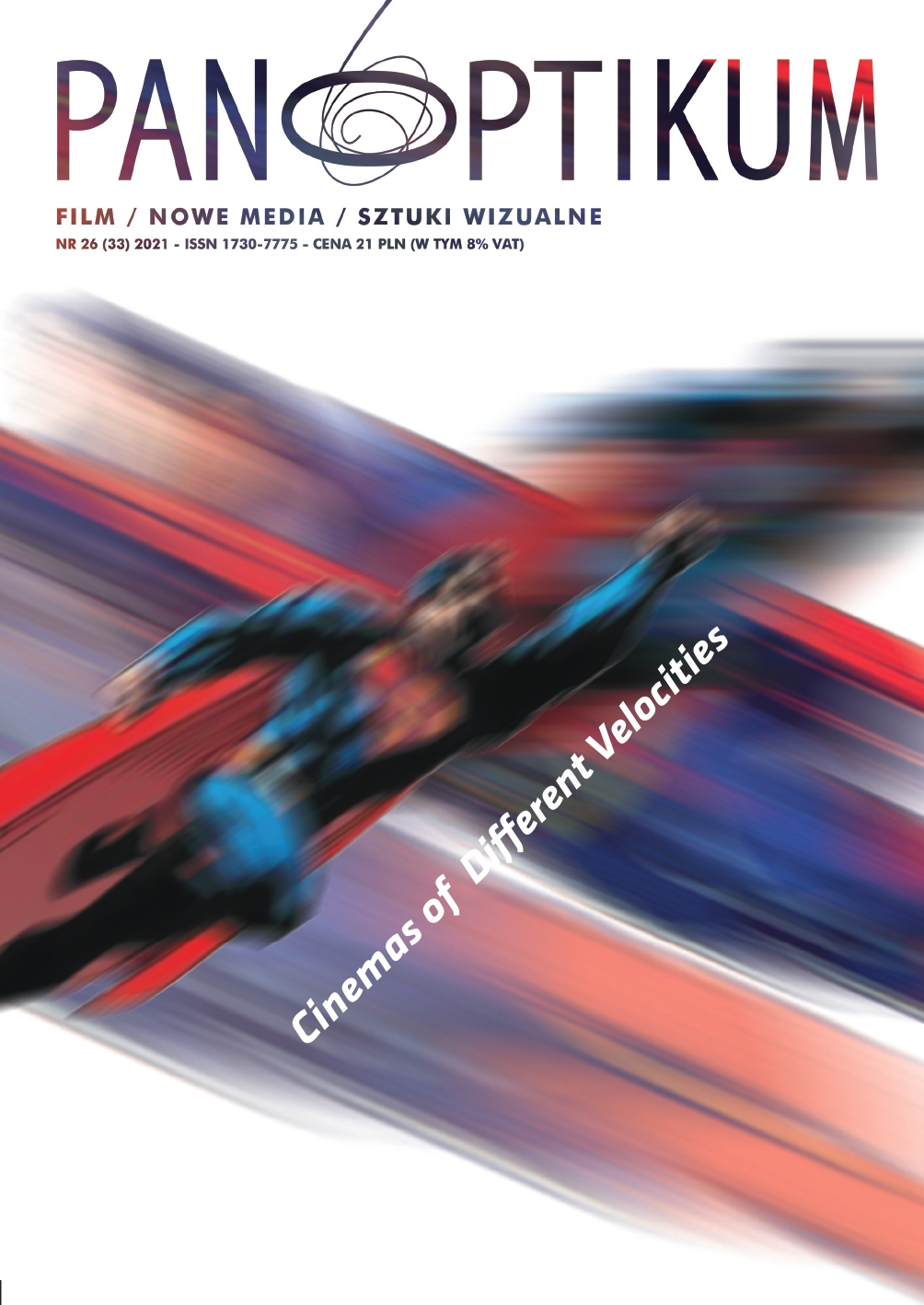Loop Structures in Film (and Literature): Experiments with Time Between the Poles of Classical and Complex Narration
DOI:
https://doi.org/10.26881/pan.2021.26.04Keywords:
puzzle films, nonlinear plot, loop structureAbstract
Among the many innovations complex or “puzzle” films have brought about in the last three decades, experiments with narrative time feature prominently. And within the category of nonlinear plots, the loop structure – exemplified by films such as Repeaters (Canada 2010), Source Code (USA/France 2011), Looper (USA/China 2012) or the TV-Series Day Break (USA 2006) – has established itself as an interesting variant defying certain norms of storytelling while at the same time conforming in most cases to the needs of genre and mass audience comprehension. In the first part of my paper, I will map out different kinds of repeated action plots, paying special attention to constraints and potentialities pertaining to this particular form. In the second part, I will address the issue of narrative complexity, showing that loop films cover a wide range from “excessively obvious” mainstream (e.g. Groundhog Day, USA 1992; 12:01, USA 1993; Edge of Tomorrow, USA/Canada 2014) to disturbing narrative experiments such as Los Cronocrimenes (Spain 2007) or Triangle (Great Britain/Australia 2009). Finally, a look at two early examples (Repeat Performance, USA 1947 and Twilight Zone: Judgement Day, USA 1959) will raise the question how singular the recent wave of loop films are from a historical perspective.
Downloads
References
Literary Works
‘12.01 p.m.’, Richard A. Lupoff, 1973 (short story)
‘12.02 p.m.’, Richard A. Lupoff, 2011 (short story)
‘By his Bootstraps’, Robert A. Henlein, 1941 (novella)
‘Doubled and Redoubled’, Malcolm Jameson, 1941 (short story)
22.63, Stephen King, 2011 (novel)
Life After Life, Kate Atkinson, 2013 (novel)
Morir (un moment abans de morir), Sergi Belbel, 1994 (play)
One Fine Day, Leon Arden, 1981 (novel)
Repeat Performance, William O’Farell, 1942 (novel)
Filmography
22.63, USA 2016 (Tv Series)
01, USA 1993
About Time, Great Britain 2013
And Then Came Lola, USA 2009
Back To The Future 1–3, USA 1985/1989/1990
Before I Fall, USA 2017
Being Erica, Canada 2009–2011 (Tv Series)
Blind Chance (Przypadek), Poland 1981
Christmas Do Over, USA 2006
Christmas Every Day, USA 1996
Dark Country, USA 2009
Day Break, USA 2006 (Tv Series) Déja Vu, USA 2006
Edge Of Tomorrow, USA/Canada 2014
Groundhog Day, USA 1992
If Only, USA/Great Britain 2004
It’s A Wonderful Life, USA 1946
Looper, USA/China 2012
Memento, USA 2000
Mine Games, USA 2012
Misfits, Great Britain 2009–2013 (Tv Series)
Mr. Destiny, USA 1990
Mr. Nobody, Belgium/Germany/Canada/France 2009
Notre Univers Impitoyable, France 2008
Peggy Sue Got Married, USA 1986
Pete’s Christmas, Canada 2013
Plus One, USA 2013
Predestination, Australia 2014
Premature, USA 2014
Primer, USA 2004
Project Almanach, USA 2015
Repeat Performance, USA 1947
Repeaters, Canada 2010
Retroactive, USA 1997
Run Lola Run (Lola Rennt), Germany 1998
Sliding Doors, Great Britain/USA 1998
Slipstream, USASouth Africa/Zambia/Germany 2005
Smoking / No Smoking, France/Italy/Switzerland 1993
Source Code, USA/France 2011
Stork Days (E Già Ieri), Italy/Spain/Uk 2004
The Butterfly Effect 2, USA 2006
The Butterfly Effect 3: Revelations, USA 2009
The Butterfly Effect, USA 2004
The Door (Die Tür), Germany 2009
The I Inside, Great Britain/USA 2004
The Last Day Of Summer, USA 2007
The Man With Rain In His Shoes, Spain/France/Gb/Germany/USA 1998
The Terminator 1–3, (USA 1984/1991/2003)
The Twilight Zone: Judgement Night, USA 1959 (Season 1, Episode 10)
The X-Files: Monday, USA 1999 (Season 6, Episode 14)
Timecrimes (Los Cronocrímenes), Spain 2007
To Die Or Not (Morir [O No]), Spain 1999
Too Many Ways To Be Nr. 1, Hong Kong 1997
Triangle, Great Britain/Australia 2009
Turn Back The Clock, USA 1933
Twelve Monkeys, USA 2015–2018 (Tv Series)
Wake Up And Die (Volver A Morir), Columbia 2011
Bibliography
Bode, C. (2013). Future Narratives: Theory, Poetics, and Media-Historical Moment. Berlin, De Gruyter.
Bordwell, D. (2002). Film Futures. “SubStance”, 31/1.
Bordwell, D. (2006). The Way Hollywood tells it: Story and Style in Modern Movies. Berkeley: University of California Press.
Brütsch, M. (2018). Complex Narration in Film: Reflections on the Interplay of Deception, Distancing and Empuzzlement. In: Perturbatory Narration in Film: Narratological Studies on Deception, Paradox and Empuzzlement, Schlickers, S., Toro, V. (eds.). Berlin: De Gruyter.
Buckland, W. (2014). Hollywood puzzle films, Buckland, W. (ed.). New York: Routledge.
Buckland, W. (2009). Making Sense of Lost Highway. In: Puzzle Films: Complex Storytelling in Contemporary Cinema, Buckland, W. (ed.). Malden: Wiley- Blackwell.
Cameron, A. (2008). Modular Narratives in Contemporary Cinema. London: Palgrave.
Elsaesser, T. (2009). The Mind-Game Film. In: Puzzle Films: Complex Storytelling in Contemporary Cinema, Buckland, W. (ed.). Malden (MA): Wiley-Blackwell.
Hermann, M. (2011). Hollywood Goes Computer Game: Narrative Remediation in the Time-Loop Quests Groundhog Day and 12:01. In: Unnatural Narratives – Unnatural Narratology, Alber, J., Heinze, R. (eds). Berlin: De Gruyter.
Johnson, S. (2005). Everything Good is Bad for You. New York: Penguin.
Kiss, M., Willemsen, S. (2017). Impossible Puzzle Films: A Cognitive Approach to Contem- porary Complex Cinema. Edinburgh: Edinburgh University Press.
Liebrand, C. (2007). “Here, We’ll Start All Over Again”: Game Over und Restart in Screwball Comedies mit dem Fokus auf Preston Sturges Unfaithfully Yours. In: Spielformen im Spielfilm: Zur Medienmorphologie des Kinos nach der Postmoderne, Leschke, R., Venus, J. (eds.). Bielefeld: Transcript Verlag.
Ramirez, B. Ch. (2006). A Taxonomy of Alternative Plots in Recent Films: Classifying the “Tarantino Effect. “Film Criticism”, 31/1–2.
Schenk, S. (2013). Running and Clicking: Future Narratives in Film. Berlin, De Gruyter.
Thompson, K. (1997). Wiederholte Zeit und narrative Motivation in Groundhog Day / Und Täglich Grüsst Das Murmeltier. In: Zeit, Schnitt, Raum. Rost, A. (ed.). Frankfurt a. M: Verlag der Autoren.
Thompson, K. (1999). Storytelling in the New Hollywood: Understanding Classical Narrative Technique. Cambridge: Harvard University Press.
Vossen, U. (2001). Die zweite Chance: Wiederholungen und Zeitschleifen im Spielfilm. In: Die Wiederholung, Felix, J. et al. (eds.). Marburg: Schüren.

 Academic Scientific Journals
Academic Scientific Journals









